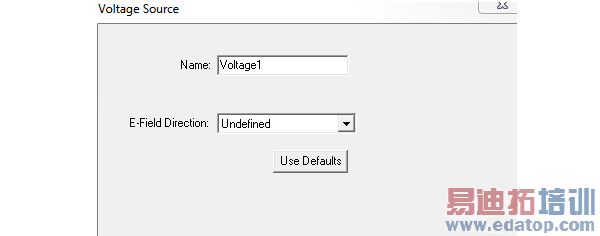- 易迪拓培训,专注于微波、射频、天线设计工程师的培养
HFSS15: Assigning Voltage Sources
A voltage source in HFSS can be defined on a surface located anywhere in the 3D problem space. Typically the source is placed on a surface between two conductors such that a user defined total voltage is maintained between the conductors. Voltage source is used when the feed structure is very small compared to the wavelength and a constant electric field may be assumed across the feed points; in this case, HFSS assigns a constant electric field across the gap on which you specified the voltage.
Note: For more information, see Voltage Source in Technical Notes.
1. Select the object face to which you want to assign the voltage source, and click HFSS>Excitations>Assign>Voltage to display the Voltage Source dialog box.

2. Specify the direction of the electric field by drawing a vector.
When the source is selected, an arrow indicates the direction and a letter v indicates the type of source.
Note: For Transient Solution types, you also designate sources as Active and Passive.
Port sources are created and solved with unit magnitude and 0 degree phase. They can be scaled within the Edit Sources dialog.
Note: The E-field direction can be reversed from the Votage Source dialog box.

Related Topics
Scaling Magnitude and Phase Using the Edit Sources dialog.
Active and Passive Excitation in HFSS Transient
Modifying Voltage Sources
HFSS 学习培训课程套装,专家讲解,视频教学,帮助您全面系统地学习掌握HFSS
上一篇:Assigning Variables
下一篇:A UHF Probe


